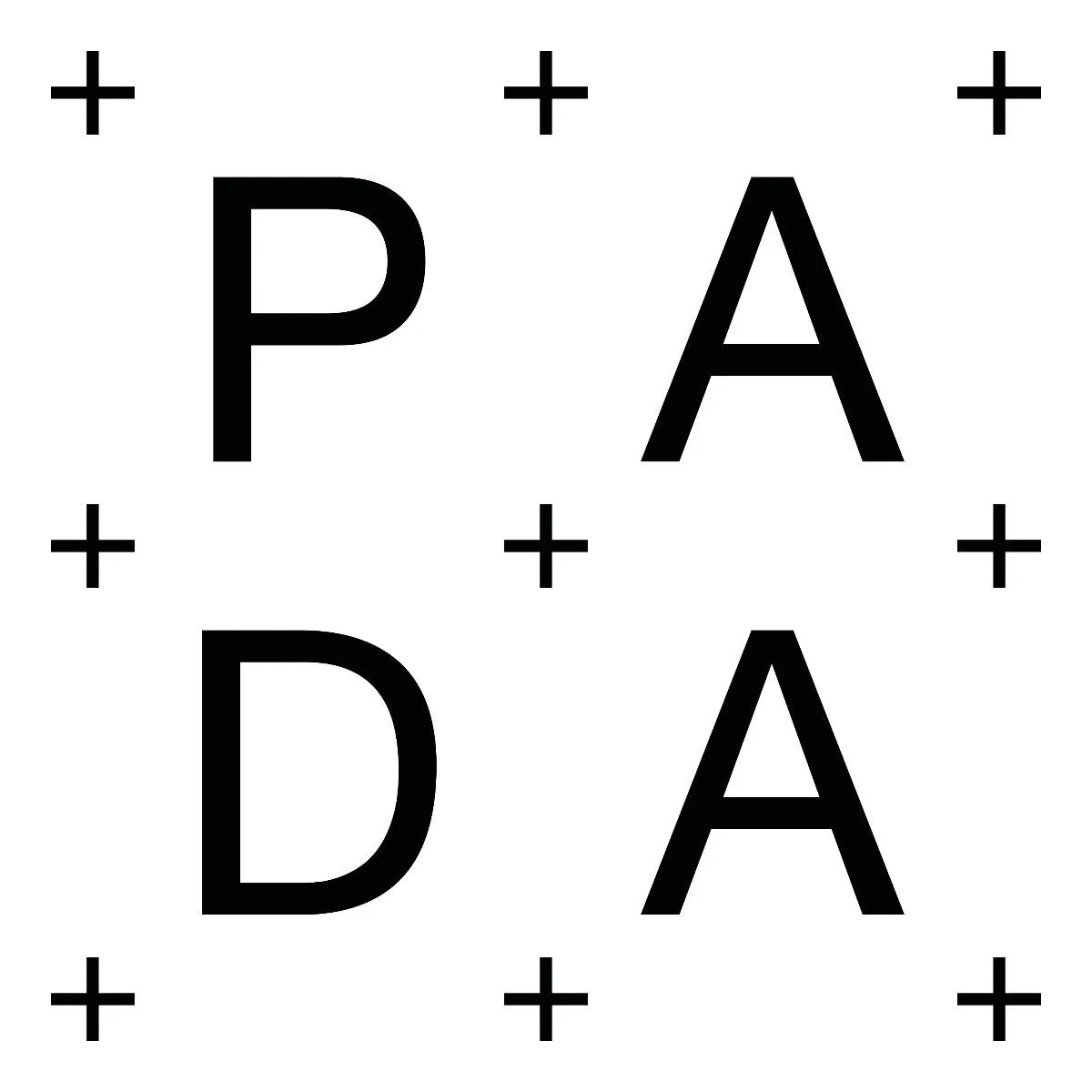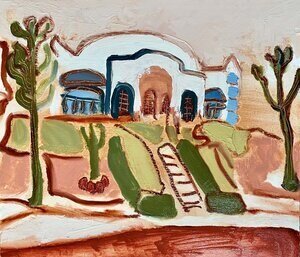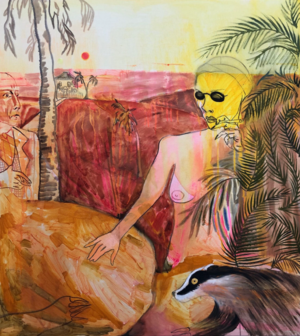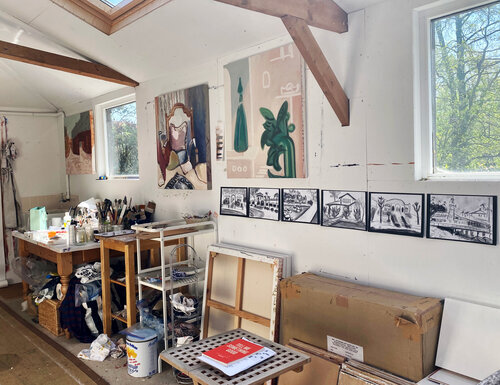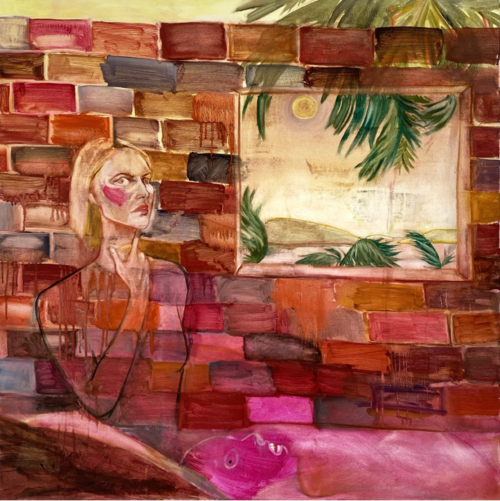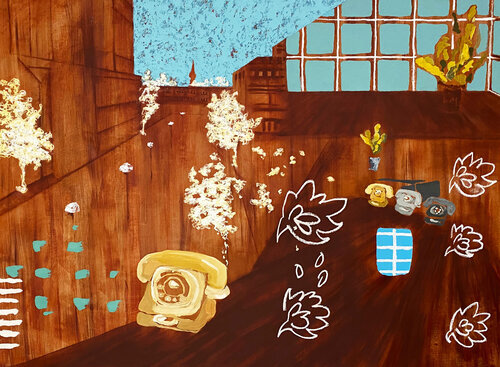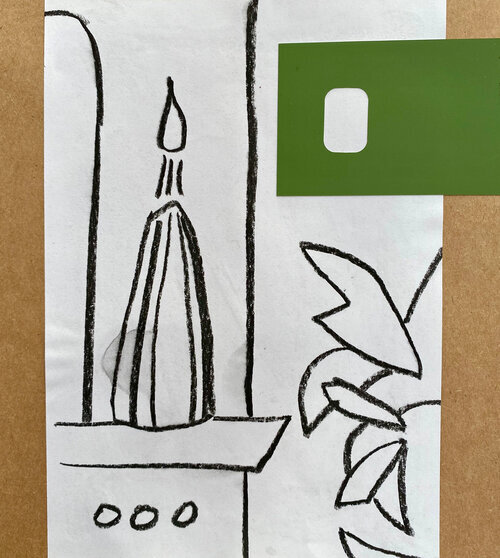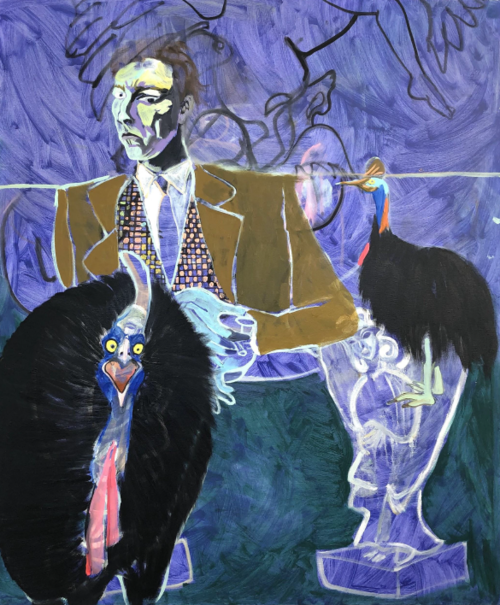LONG RANGE STUDIO VISITS
Amy Robson and Amalia Mourad
In this conversation as part of our Long Range Studio Visits series we introduce Amy Robson and Amalia Mourad. In this article they discuss the subjective response to an environment, systems of accessing the unconscious whilst painting and producing work with instinct and raw emotion.
Amy Robson, ‘‘Lemon Grove Avenue (Chinatown)’’, 35 x 40, oil on board
Emerging from the artistic experience of not-knowing, Amy Robson’s paintings explore loss, disillusionment and contemporary collective anxiety. Through disjointed pictorial space, anthropomorphic forms and diverse painterly tropes, the work investigates hegemonic systems of power and control. Though rooted in the real world, the paintings push representational boundaries with their bold colours, energetic brush marks and abject mash-ups of historic and cultural references.
Amalia Mourad, “Dachs II”, 100 x 90cm, oil on canvas, 2019 (Berlin)
Amalia Mourad was born and raised in Berkeley, California. Currently lives and works in Berlin. She paints and draws daily human experiences, the subconscious, and intimate relationships using the figure and portraiture to explore sexuality, humor and emotion. The paintings are an accumulation of characters and objects that have escaped from all different parts of the psyche.
Amy Robson, studio view
Amy Robson: Hi Amalia, It was a pleasure to meet you on the phone and to talk about motivation, process, materials, grad school and PADA experiences. We are both US ex-pats living in Europe and remarkably we have both made work in Portugal, Berlin, London and the US. How do you feel your geographic environment influences your work? And has this changed in the past six weeks since lockdown? Your painting ‘Quarantine’ was completed just as the world was preparing for the onset of the pandemic.
Amalia Mourad, “Quarantine”, 115 x 110cm, oil on canvas, 2020 (PADA Studios Residency, Lisbon)
Amalia Mourad: Hi Amy, it was great to chat with you as well. My decisions of landscape and atmosphere are all unconscious, as I work more from instinct and feeling rather than clear planning. Rarely do I sketch out an idea before beginning a painting. In order to allow a deeper investigation of internal conflicts and motives, I leave the analysis of the painting to after its completion. That means that sometimes titles come late. I came up with the name "Quarantine" about a month after I finished the painting. My daily schedule under quarantine has not changed all that much, my side job as a caregiver is deemed essential. But I am curious if I will see some developments in my work influenced by social changes we've all experienced looking back a month or two from now.
My work has always been influenced by my surroundings. I often find I am painting what I am missing rather than what I have around me. For example, after I moved to Berlin in October 2018, I found myself painting a lot of hills, bright, juicy colors, foliage, and an endless sun. And ever since I returned to Berlin after having finished the PADA residency, I have been painting the sea, and I remembered taking that boat into Lisbon and crossing the bay. I grew up with the ocean and I think my time at PADA reminded me of its importance.
I would ask you the same questions you asked me, and would also add a question about colour... How has place affected your palette, are the two directly connected for you? And we can perhaps continue the conversation a bit on that last idea of consciousness. How do you "let go" when you are making? Is there a specific state of mind that you hope to access when painting or drawing?
AR: Hi again Amalia, not only does the geographic environment impact my work, it is at the heart of my practice. I am not interested what a place or space looks like per se, but rather am interested in my subjective response to the experience of being in a place. Like you I have found that I am painting what I am missing. When lockdown began, I thought that I would be painting the natural beauty around me in the countryside, but rather I am drawn to painting places that I can’t access - and in a darker mood register. I just finished a series of paintings inspired by the classic film noir ‘Chinatown’. It appears I am trying to escape to 1930s L.A. via a 1974 aesthetic.
Colour is fundamental to the experience of place for me. For example, the austere dark wood colour of 1980’s Soviet era interiors underpins my ‘Stasi’ series which was made from my sketches of the former East German Stasi Headquarters in Berlin. The banal details of turquoise kitchen tiles, mustard telephones and mauve-white net curtains serve as colourful counterpoints to the atrocities that were happening in the space (see ‘Drei Große Telefone’ and ‘Breakfast for the Minster’).
Your question of planning vs. letting go highlights our different ways of trying to achieve the same thing. Whereas you can access instinct and feeling naturally in the painting process, I have to trick my conscious mind into accessing the intuitive side of things. Drawing from direct observation (and ideally quickly) keeps me from over-thinking; and I enjoy being surprised by my wonky marks and weird observations. When painting, I try to keep the integrity of the wonkiness and weirdness by telling myself to ‘not think’ so I don’t second-guess the original drawings. This allows for freer, more fluid mark-making.
I wonder if you could elaborate more about how you paint intuitively and how you access the diverse and captivating figures and motifs employed in your paintings? Tigers, aardvarks, badgers, people, art history references, and a girl with tan lines. How much do you have to edit your work to achieve a balance between diversity and coherence?
Amy Robson, ‘‘Breakfast for the Minister’’, 140 x 190, oil on canvas
AM: Accessing is an interesting word you use: sometimes it does feel like I am entering a portal when painting portraits and figures. I feel like I am acting. I often catch myself making the same expression I am painting, sometimes I cry - I really feel like I become the character I am painting. This is a special, heightened, and very personal space for me. It’s less about thinking and more about accessing a deeper part of my psyche and raw human emotion. Starting this process is almost like deciding to jump off a diving board. I might be staring at the canvas for a long time waiting for that bottom-of-the-stomach “that’s it” feeling when a character reveals itself to me. Then I’ll stand up and think, OK here we go.
I wouldn’t say I have any issues editing whether to put a character or object in or not. Some characters and objects keep returning, sometimes for many years. I form an attachment to them, they are almost like an odd collection of family members. They tend to take on a life of their own, developing certain traits and characteristics the more I paint them. It gets easier and easier knowing when I am honest about what I am painting. Other artists will know what I am talking about: really listening to the gut and instinct about what feels right and stimulating and investigative and emotional. It’s really easy to just get hooked on reproducing a gimmick or process over and over that works visually - I find this boring and mechanical. I want each painting to discover something new, I don’t want to be chained to any formula or technique.
It’s really nice to see your drawings paired with the paintings. I find myself looking back and forth between them. Seeing them next to each other provokes me to search for your state of mind, rhythm, and intention when you were making them. Also, I don’t think I have previously seen “As Little as Possible.” This piece feels very confident and inviting and at the same time sterile and cold.
You said you are interested in your subjective response of being in a space…does this mean you have to draw or paint while physically there? Or is it sufficient to paint or draw from a memory of feeling of a space?
Amy Robson, ‘‘As Little As Possible’’, sketch 40 x 30 cm, charcoal on paper with collage
AR: Hi Amalia, diving board – yes! I know the feeling… That quality is necessary not only to start a work, but also a necessary approach to a day’s painting session. I find I make my work-in-progress less good when I am just wading into it from the edge of the pool. Making incremental changes. Dab, dab, dab. ‘Flabby’ painting (an insightful criticism from artist Phil King while at PADA). On those days when I’m not up for the shock of the plunge, I should just prime some boards or tidy up my studio… OR just pull up my socks and jump in.
Funny you should mention ‘As Little as Possible’. A good example of jumping in. I set myself the task of starting and finishing that painting in one session. I was painting over an old unsuccessful canvas and I gave myself the additional challenge of trying to complete the painting by doing ‘as little as possible’. Economy of mark-making forced me to make bolder choices – an insight I should keep in mind.
I really like the way you think about your subjects as autonomous characters beyond your control. I am struck by the inclusion of animals and people within a picture – aware of each other or not - and entering or exiting the space. The placement of the figures activates the space between them and brings the viewer into the image. Like you, we become characters in your play. This is subtly reinforced by the direct gaze of your subjects (‘Isolation Man’, ‘Quarantine’, ‘Dachs’).
Regarding physically being in the space; I prefer it to painting from memory. I am against painting from photos, because I find the limits of ‘The Rectangle’ to be too stifling. I like the random observations that occur when I engage my peripheral vision. By sitting in just one place and by drawing from observation I can create an infinite source of images. This is the underlying concept of my upcoming show in the US. The entire body of work was created by sketches made by sitting on just one rock over the course of six weeks last summer.
Back to your work, I am really interested in the balance between humour and pathos. I am intrigued by your sad old men or pensive young women juxtaposed not just with the aforementioned animals, but also with banal details of devilled eggs, lemons or cartoonish tan-lines. Sublime/banal. It’s ripe territory. What are your thoughts on this balance?
Amalia Mourad, “Isolation Man”, 120 x 100cm, oil on Canvas, 2019 (Berlin)
AM: HA! I love this term ‘flabby painting.’ What a great term. I also know what you mean by wading towards a work. I like that imagery as well.
I find it interesting when artists paint over old canvases. This is something I did quite often in New York because of a lack of space and also as a way to save money while living in such an expensive city. It was also an important process for me to learn in terms of letting go. There were often sections of paintings which I found very successful and would become attached to, but there was no way of solving the painting by working around it. I had to learn to paint over things, detach, make a sacrifice, in order to to commit to the whole. I also made a series of works where I found a bunch of old canvases in the trash by undergraduate students and I painted on top of them. I had originally thought I would just gesso over them, but there were certain parts that were painted so carefully and there were characters and objects that were begging to have another life. As I added in characters and scenes on top I began a conversation with another person on the canvas. The end result was two worlds mashed together, both harmonious and competing. It was sometimes hard to tell what I had painted and what the other person had painted. The paintings were quite funny, they made fun of old white men, they were sexual, and silly, but also dark. I really love when I see humour in other works. Sometimes the art world is filled with too much heaviness, seriousness, and jargon. This whole process was also about authority, it became a power move in sense, I claimed ownership over someone else’s work and called it my own.
Congratulations on your show! It makes me happy to hear about your process. It really sounds like you are slowing down and inserting yourself into a place and time. I find a lot of artists are constantly jumping from one work to the next with intensity and flashiness. Almost like an advertisement. We forget to take a breath sometimes and appreciate what is right in front of us.
In terms of finding this balance in my paintings, I think life is full of many emotions. For me personally, it can be very emotionally volatile. I like the idea of mixing humour with death, I am interested in having multifaceted characters that are sexual, scared, vulnerable, proud, nostalgic, or creepy. I find the more ambiguity I put into a painting the more the viewer is able to project onto it. It allows the viewer to come up with their own story about the painting rather than having me tell them so clearly what is happening. I believe memory and communication are processed by each individual through projection and perspective. There is no one truth about experience or understanding. My paintings also do not have one truth. The analysis and story changes for me over time.
For more information and to see more examples of work visit
